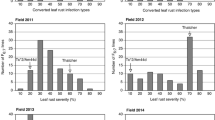Summary
Genotypes of Phaseolus vulgaris differ in their level of resistance to Empoasca kraemeri, but the speed with which these differences can be accumulated into a resistant variety will depend on whether they can be detected in single F2 plants, and on whether the genetic control of resistance is additive. Thirty-eight homozygous genotypes were therefore grown in small plots with and without insecticidal protection, and also in ‘simulated F2 populations’ containing one plant of each genotype. In addition, the F2 and F3 generations of crosses were studied. Both generations of a 13 parent diallel were grown with and without insecticidal protection. Six crosses, involving some of the parents in the diallel and two additional genotypes, were studied in more detail. Protected and unprotected F2 plants from these crosses were harvested individually, and the resulting F3 families were grown with and without protection. In all the expriments, the level of damage to the unprotected plants and the vigour of the protected plants was assessed visually by means of a numerical score, and the seed yield was measured.
The performance of a single homozygous plant was a reasonable predictor of the performance of the same genotype in a small plot, but in the six crosses studies in detail, the correlations between F2 and F3 performance were low. In the analysis of the diallel cross, the significant differences among crosses were due to specific combining ability and not general combining ability. These results indicate that the genetic control of resistance is largely non-additive, and that F2 selection will probably be ineffective. However, F3 selection should be effective, and transgressive segregants for resistance should be obtainable.
In some of the six crosses, the F3 families differed both in general vigour and in narrow-sense resistance to E. kraemeri, as defined by Galwey & Evans (1982). The visual assessment of damage symptoms in each plot was related to the subsequent seed yield of the plot, but was more heritable than yield. The relationship between these two variables was investigated by the genetic correlation coefficient and by an alternative method, and was found to be partly genetically determined, but partly due to the influence of environmental factors on both variables. This indicates that screening for E. kraemeri resistance should be done by means of a visual damage score in a carefully chosen, uniform environment.
Similar content being viewed by others
References
Anon, 1976. Descriptive list of the Phaseolus spp. germplasm. I. Promising materials. Centro Internacional de Agricultura Tropical.
Gruz, C., 1976. Resistencia de fríjol, Phaseolus vulgaris a Empoasca spp. en Puerto Rico. Programa Cooperativo Centroamericano de Cultivos Alimenticios, San José, Costa Rica.
Frey, K. J. & T., Horner, 1957. Heritability in standard units. Agron. J. 49: 59–62.
Galwey, N. W., 1980. Breeding the common bean, Phaseolus vulgaris L., for resistance to the leafhopper Empoasca kraemeri Ross & Moore. University of Cambridge, Ph.D. dissertation.
Galwey, N. W. & A. M., Evans, 1982. Altenative methods or interpreting measurements of resistance to the leafhopper Empoasca kraemeri Roos & Moore, in the common bean, Phaseolus vulgaris L. Euphytica. 31: 225–236.
Griffing, B., 1956. Concept of general and specific combining ability in relation to diallel crossing systems. Aust. J. Biol. Sci. 9: 463–493.
Kehr, W. R., R. L. O., Ogden & S. D., Kindler, 1970. Diallel analysis of potato leafhopper injury to alfalfa. Crop. Sci. 10: 584–586.
Manglitz, G. R. & J. L., Jarvis, 1966. Damage to sweet clover varieties by potato leafhopper. J. Econ. Entomol. 59: 750–751.
Newton, R. C. & D. K., Barnes, 1965. Factors affecting resistance of selected alfalfa clones to the potato leafhopper. J. Econ. Entomol. 58: 435–439.
Painter, R. H., 1951. Insect resistance in crop plants. The University Press of Kansas, Lawrence and London. 520 pp.
Robertson, A., 1959. The sampling variance of the genetic correlation coefficient. Biometrics 15: 469–485.
Sanford, L. L. & J. P., Sleesman, 1974a. Selection for resistance to potato leafhopper in potatoes. I. Selection methods. American Potato J. 51: 44–50.
Sanford, L. L. & J. P. Sleesman, 1947b. Genetic variation in population of tetraploid potatoes: response to the potato leafhopper and the stem flea beetle. Research summary, Ohio Agricultural Research and Development Center, No. 72, 33–34.
Sleesman, J. P. & F. J., Stevenson, 1941. Breeding a potato resistant to the potato leafhopper. Am. Potato J. 18: 280–298.
Author information
Authors and Affiliations
Rights and permissions
About this article
Cite this article
Galwey, N.W., Evans, A.M. The inheritance of resistance to Empoasca kraemeri Ross & Moore in the common bean, Phaseolus vulgaris L.. Euphytica 31, 933–952 (1982). https://doi.org/10.1007/BF00039233
Received:
Issue Date:
DOI: https://doi.org/10.1007/BF00039233




